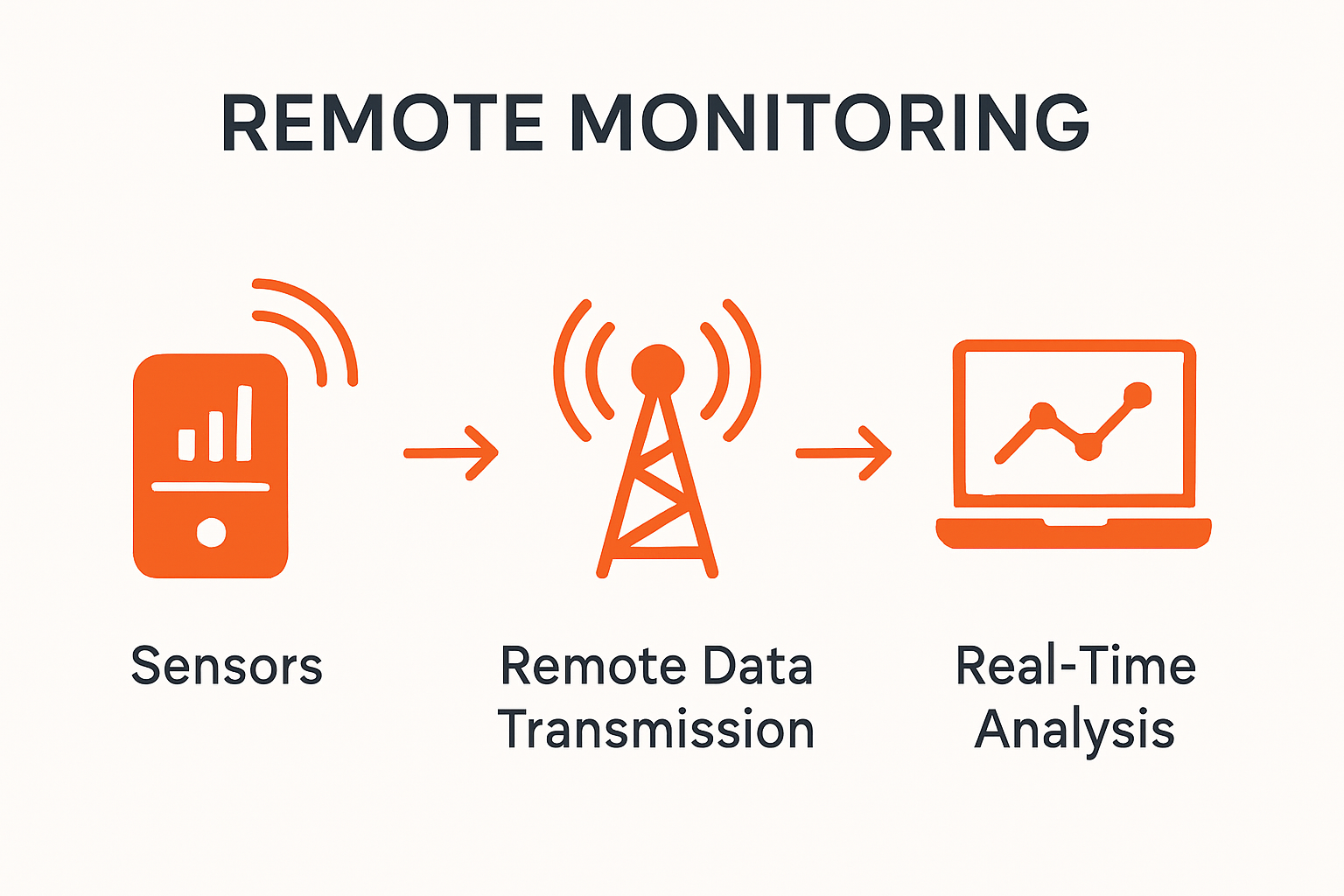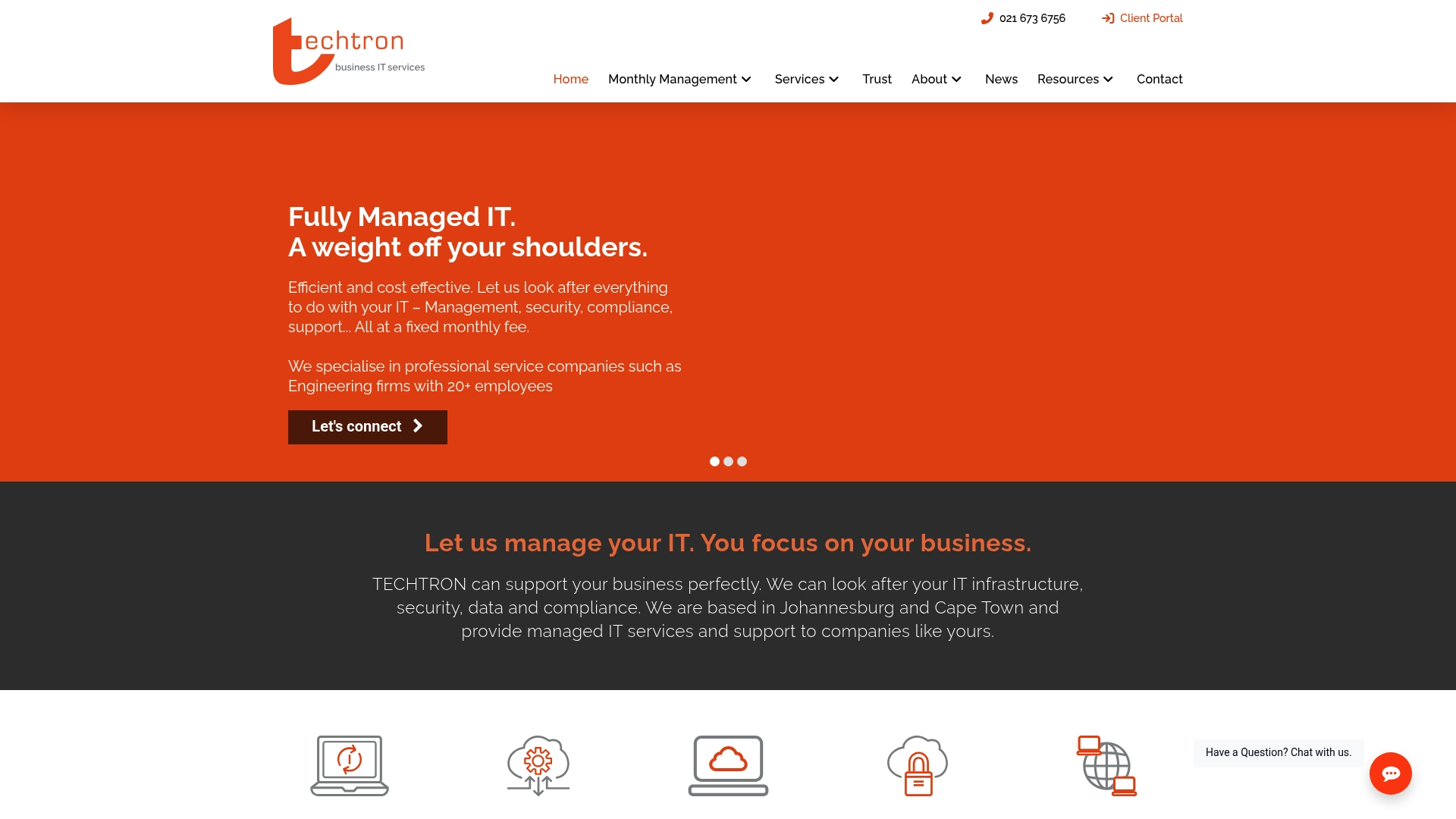What Is Remote Monitoring? A Guide for South African Businesses 2025

South African businesses are turning to remote monitoring to stay ahead in a fast-changing world. Here’s the wild part. One local mine saved an estimated R20 million just by using condition monitoring systems to spot critical failures before they happened. But what really catches people off guard is how this technology is just as much about protecting staff and boosting cybersecurity as it is about keeping equipment running. The real advantage goes beyond savings and reaches deep into business resilience.
Table of Contents
- Understanding What Is Remote Monitoring
- Key Benefits For Mid-Sized Businesses
- Remote Monitoring And Cybersecurity Protection
- Choosing The Right Remote Monitoring Provider
Quick Summary
| Takeaway | Explanation |
|---|---|
| Real-time Insights | Remote monitoring enables businesses to detect potential equipment failures, optimize performance, enhance security, and reduce costs, transforming operations from reactive to proactive. |
| Benefits for Mid-Sized Businesses | Mid-sized organizations can utilize remote monitoring for improved productivity, strategic talent acquisition across geographies, and enhanced cybersecurity measures tailored to their specific vulnerabilities. |
| Comprehensive Evaluation of Providers | Businesses should conduct thorough due diligence when selecting remote monitoring providers, focusing on technical capabilities, industry experience, and transparency through robust service level agreements. |
| Continuous Collaboration | Maintaining adaptive partnerships with remote monitoring providers is crucial for ongoing risk assessment, threat detection, and ensuring the flexibility required to navigate evolving technological landscapes. |
Understanding What Is Remote Monitoring
Remote monitoring is a sophisticated technological strategy that enables businesses to track, analyze, and manage critical systems and processes from a distance. At its core, remote monitoring involves using specialized software and hardware to collect real-time data from various devices, networks, and infrastructure components without requiring physical presence.

The Fundamental Mechanics of Remote Monitoring
The process begins with strategically placed sensors and monitoring tools that continuously gather performance metrics, operational status, and potential anomalies across different technological environments. These sensors transmit data through secure network connections to centralized monitoring platforms, allowing technical teams to assess system health, predict potential issues, and respond proactively.
In the South African context, remote monitoring has gained significant traction across multiple industries. Research from the National Mines Repository highlighted that implementing condition monitoring systems in gold mining operations led to substantial cost savings, with one study demonstrating an estimated R20 million saved by preventing critical machine failures.
Legal and Ethical Considerations
Understanding remote monitoring also requires navigating complex legal frameworks. In South Africa, the Regulation of Interception of Communications and Provision of Communication Related Information Act (RICA) provides crucial guidelines. The act generally prohibits unauthorized monitoring, emphasizing the importance of obtaining proper consent and maintaining transparency when implementing remote monitoring solutions.
Moreover, the COVID-19 pandemic accelerated remote monitoring adoption across various sectors. Healthcare research demonstrated how telemonitoring guidelines expanded, allowing professionals to remotely track chronic conditions and follow up on acute medical situations, showcasing the versatility and critical nature of remote monitoring technologies.
Key Benefits for South African Businesses
Remote monitoring offers businesses multiple strategic advantages. Real-time insights enable organizations to:
- Predictive Maintenance: Detect potential equipment failures before they occur
- Performance Optimization: Continuously track system efficiency and productivity
- Security Enhancement: Monitor network and infrastructure for potential cybersecurity threats
- Cost Reduction: Minimize downtime and prevent expensive emergency repairs
By implementing robust remote monitoring strategies, South African businesses can transform their operational approach from reactive problem-solving to proactive system management. The technology provides a comprehensive view of organizational infrastructure, empowering decision-makers with actionable intelligence and supporting more efficient, secure, and resilient business operations.
Here is a summary table outlining the main benefits of remote monitoring for South African businesses as discussed above:
| Benefit | Description |
|---|---|
| Predictive Maintenance | Detect potential equipment failures before they occur |
| Performance Optimization | Track system efficiency and productivity in real-time |
| Security Enhancement | Monitor and protect against cybersecurity threats |
| Cost Reduction | Reduce downtime and avoid expensive emergency repairs |
| Proactive Management | Shift from reactive problem-solving to proactive system health management |
Key Benefits for Mid-Sized Businesses
Mid-sized businesses in South Africa face unique operational challenges that make remote monitoring an increasingly critical strategic tool. Unlike large enterprises with extensive resources or small startups with minimal infrastructure, mid-sized organizations require flexible, cost-effective solutions that can adapt quickly to changing technological landscapes.
Enhanced Operational Efficiency and Productivity
Remote monitoring provides mid-sized businesses with unprecedented insights into their operational performance. Research from Axia Consulting reveals that implementing remote monitoring policies can significantly boost employee productivity. By eliminating traditional workplace disruptions and reducing commuting times, businesses can create more focused and efficient work environments.
The ability to track performance metrics in real-time allows management to:
- Identify bottlenecks in workflow processes
- Optimize resource allocation
- Implement data-driven decision-making strategies
- Continuously improve operational workflows

Strategic Talent Acquisition and Cost Management
Remote monitoring technologies enable mid-sized businesses to transcend traditional geographical limitations in talent recruitment. Axia Consulting research indicates that companies can now access skilled professionals from diverse regions, including areas with lower living costs. This approach not only diversifies team capabilities but also provides significant financial advantages.
The cost-saving potential is substantial. By reducing expenses related to physical office spaces and associated overheads, businesses can strategically redirect funds towards:
- Technology upgrades
- Employee training programs
- Innovation initiatives
- Strategic business expansion
Cybersecurity and Risk Management
Mid-sized businesses are often more vulnerable to cybersecurity threats compared to larger corporations with extensive security infrastructure. Remote monitoring provides a critical layer of protection by enabling continuous network surveillance, threat detection, and rapid incident response.
Key security benefits include:
- Real-time threat detection
- Automated security protocol enforcement
- Comprehensive network visibility
- Proactive vulnerability management
By implementing robust remote monitoring strategies, mid-sized South African businesses can transform their operational approach. The technology offers a comprehensive solution that addresses productivity, talent management, cost optimization, and cybersecurity challenges. As the business technology landscape continues to evolve, remote monitoring emerges as an essential tool for organizations seeking competitive advantage and sustainable growth.
Below is a table summarizing key advantages of remote monitoring for mid-sized businesses across critical areas:
| Area | Key Advantage |
|---|---|
| Operational Efficiency | Identify bottlenecks, optimise resources, improve workflows |
| Talent Acquisition | Access skilled professionals from wider geographies |
| Cost Management | Cut office and overhead expenses, invest in innovation |
| Cybersecurity & Risk Management | Real-time threat detection and rapid incident response |
Remote Monitoring and Cybersecurity Protection
Cybersecurity protection has become a critical cornerstone of modern business operations, with remote monitoring emerging as a powerful defensive strategy against increasingly sophisticated digital threats. As South African businesses navigate complex technological landscapes, understanding the intricate relationship between remote monitoring and cybersecurity is paramount.
Comprehensive Threat Detection and Response
Remote monitoring transforms cybersecurity from a reactive to a proactive discipline. The Council for Scientific and Industrial Research (CSIR) has established a dedicated Information and Cybersecurity Research Centre focused on developing home-grown solutions that address identity management and protect digital systems against emerging vulnerabilities.
Advanced remote monitoring technologies enable businesses to:
- Continuously scan network environments
- Identify potential security breaches in real-time
- Track unauthorized access attempts
- Generate immediate threat alerts
Regulatory Compliance and Risk Management
A 2024 study analyzing IT risks in South African government remote work environments revealed significant gaps in managing IT risks and recovery processes. Not all organizations have adopted comprehensive frameworks like the National Institute of Standards and Technology (NIST), highlighting the critical need for structured cybersecurity approaches.
Remote monitoring supports regulatory compliance by:
- Documenting security incidents
- Maintaining comprehensive audit trails
- Ensuring consistent security protocol enforcement
- Providing detailed forensic evidence if required
Skill Development and Technological Innovation
Addressing cybersecurity challenges requires more than technological solutions. The University of Johannesburg, supported by a Google.org grant, launched a cybersecurity training program in 2025 aimed at equipping professionals with advanced skills to protect digital infrastructure.
Remote monitoring plays a crucial role in skill development by:
- Providing practical learning environments
- Offering real-world security scenario simulations
- Creating opportunities for hands-on threat analysis
- Supporting continuous professional education
By integrating sophisticated remote monitoring strategies, South African businesses can build resilient cybersecurity ecosystems. This approach goes beyond traditional defense mechanisms, creating adaptive, intelligent systems that anticipate, detect, and neutralize potential threats before they can cause significant damage.
The convergence of remote monitoring and cybersecurity represents more than a technological trend. It is a fundamental shift in how organizations protect their digital assets, ensuring business continuity, maintaining stakeholder trust, and creating a robust foundation for sustainable digital transformation.
Choosing the Right Remote Monitoring Provider
Selecting an appropriate remote monitoring provider represents a critical strategic decision for South African businesses. The right partner can significantly enhance operational efficiency, cybersecurity, and technological resilience, while the wrong choice can introduce substantial risks and operational challenges.
Comprehensive Due Diligence and Evaluation
Research from Security SA emphasizes the importance of thorough investigation when selecting a remote monitoring service provider. Businesses must go beyond surface-level assessments and conduct in-depth evaluations that encompass multiple critical dimensions.
Key evaluation criteria should include:
- Technical capabilities and infrastructure
- Industry-specific experience
- Scalability of monitoring solutions
- Proven track record of successful implementations
- Compliance with local and international security standards
Businesses are advised to obtain comprehensive client references and assess the provider’s ability to mitigate potential risks. A strategic approach involves considering multiple providers and potentially using separate suppliers for different monitoring services to prevent potential collusion and ensure comprehensive coverage.
Service Level Agreements and Transparency
An effective monitoring and evaluation system is fundamental to managing remote monitoring services successfully. Establishing a robust service level agreement (SLA) becomes critical in defining expectations, performance metrics, and accountability mechanisms.
Crucial elements of a comprehensive SLA include:
- Precise performance benchmarks
- Response time guarantees
- Incident resolution protocols
- Reporting mechanisms
- Continuous improvement commitments
Transparency emerges as a non-negotiable requirement. Businesses must ensure that providers offer clear, detailed insights into their monitoring processes, technological capabilities, and potential limitations.
Adaptive and Collaborative Partnerships
Security experts recommend maintaining a dynamic and collaborative relationship with remote monitoring providers. This approach recognizes that technological landscapes and security threats continuously evolve, necessitating flexible and responsive partnerships.
Strategic collaboration involves:
- Regular procedural updates
- Ongoing risk assessment
- Mutual knowledge sharing
- Proactive threat detection strategies
- Continuous skills development
By prioritizing comprehensive evaluation, transparent communication, and adaptive partnerships, South African businesses can select remote monitoring providers that not only meet current technological requirements but also position the organization for future growth and resilience. The right provider transforms remote monitoring from a mere technical service into a strategic business enabler, driving operational excellence and technological innovation.
Frequently Asked Questions
What is remote monitoring?
Remote monitoring is a technological strategy that allows businesses to track and manage systems and processes from a distance using specialized software and hardware to collect real-time data.
How does remote monitoring benefit South African businesses?
Remote monitoring enhances operational efficiency by enabling predictive maintenance, optimizing performance, improving cybersecurity, and reducing costs associated with equipment failures and downtime.
What are the legal considerations surrounding remote monitoring in South Africa?
In South Africa, the Regulation of Interception of Communications and Provision of Communication Related Information Act (RICA) mandates obtaining proper consent and maintaining transparency regarding monitoring practices.
How can mid-sized businesses leverage remote monitoring?
Mid-sized businesses can use remote monitoring to improve productivity, access talent from wider geographical regions, and bolster their cybersecurity measures, thus transforming operational challenges into opportunities.
Take Control of Risk with Trusted Remote Monitoring IT Partners
The risks and challenges discussed in this article may sound familiar to you. From rising cybersecurity threats to outdated monitoring systems, many professional firms and mid-sized companies end up reacting to crises rather than preventing them. You have seen how business resilience relies on real-time insights and proactive threat detection. If you are looking for a way to turn those vulnerabilities into a competitive advantage, Techtron is ready to help. Our Managed IT Solutions give you the preventative power, compliance support and advanced security South African businesses need in today’s environment.

Why wait until equipment fails or security is breached? Shift your focus from firefighting to future-proofing. Contact the Techtron team now through our main site and discover how a partnership with us means proactive monitoring, responsive support and technology tailored for your growth. Book a free consultation today to find out how you can optimise your business and protect your data before the next risk appears.